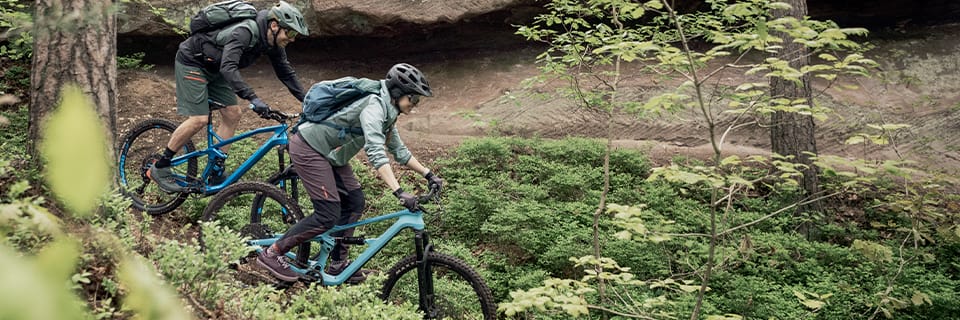Cross-Country (or XC) is a long-standing mountain bike discipline that covers very different realities, depending on the level at which it is practised. Practised on increasingly technically demanding courses at the highest level, XC can also be seen as a fast-paced ride with no other ambition than to expend energy in a natural setting. The choice of bike will then be very different.
What is Cross-Country / Marathon?
Cross-Country (or XC) is the oldest discipline, and certainly still the most popular, involving a series of climbs, descents and rolling sections on natural courses or circuits of varying lengths. It requires no special infrastructure and can be enjoyed all year round, in all regions.
The very essence of MOUNTAIN BIKINGCross-country is accessible to all levels, whether you are looking for leisure mountain biking or high-level competition. Visit bike ranges in this family are very broad, to cover all situations, particularly in terms of the topography of the region where you want to ride, your riding style and your budget.
WHICH FRAME FOR MY RIDING?
Before choosing a mountain bike frameyou first need to determine your objective. If you're looking for comfort and sturdiness for leisure, the main criteria - more than in any other mountain bike discipline - will be lightness and responsiveness to meet the demands of continuous changes of pace. These points, obviously conditioned by your budget, will naturally lead you to opt for a steel or aluminum frame in the first case, and a carbon frame in the second.
In addition to the choice of material, the other important point to decide on is the choice of frame. semi-rigid mountain bike or a full-suspension mountain bike. While kinematics have made enormous strides in recent years, virtually eliminating any pumping effect when pedaling and thus greatly erasing differences in performance, notable differences remain. For the same price range, a semi-rigid model will be lighter, easier to maintain and more affordable. The full-suspension model, on the other hand, offers greater comfort, traction and shock absorption.
Finally, the last criterion to take into account is the wheel format: 26" for a more manoeuvrable and responsive bike, but which has all but disappeared from the manufacturers' catalog (now mainly reserved for juniors); 27.5" for a good compromise between responsiveness and ease of handling (ideal for people between 1.60 and 1.70 m tall); 29" for a more rolling bike with greater climbing ability (which can be considered for riders over 1.70 m tall). It's worth noting that the 27.5+ (27.5" wheels allowing very wide tires to be fitted) is a hybrid format offering greater comfort and stability, as well as versatility, since many 27.5+ models allow both 27.5+ and 29" wheels to be fitted.
WITH WHAT EQUIPMENT?
MTBs designed for XC use relatively short suspensions, with travel generally ranging from 100 to 120 mm, and locking options to ensure that rolling, climbing or descending phases are tackled in the best possible conditions. These can often be activated directly from the handlebars, so you don't have to waste a single second.
When it comes to drivetrains, the single-plate system (1x11 or 1x12V) is becoming increasingly popular for its lightness, simplicity and efficiency. But leisure cyclists will be more at home with a double or even triple crankset, combined with a 10 or 11-speed cassette for greater versatility and peace of mind on the climb.
The rest of the components are generally fairly identical, whatever the model, with disc brakes disc brakes, usually hydraulic, with 160 to 180 mm-diameter discs, and wheels that are increasingly compatible with tubeless or tubeless-ready mounting, offering not only maximum protection against punctures, but also better traction and greater comfort. Last but not least, top-of-the-range models can be supplied with a telescopic seatpost, enabling the rider to instantly adopt the ideal position for both uphill and downhill riding.
Découvrez tous nos conseils & Tutoriels
